#julie mitchum
Text






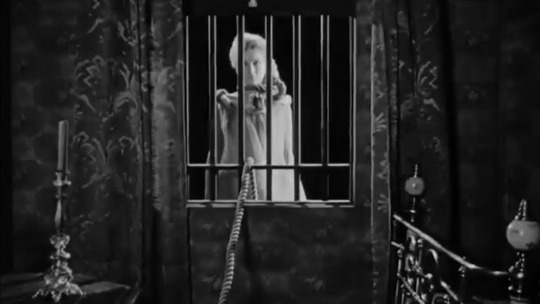

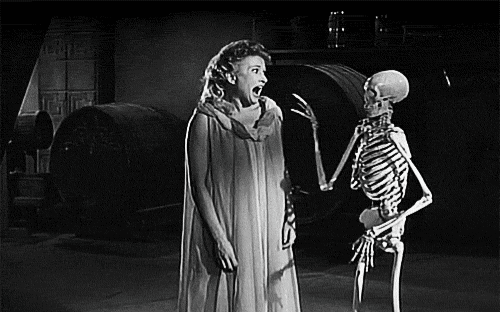

#house on haunted hill#1959#vincent price#carol ohmart#richard long#carolyn craig#elisha cook jr.#alan marshal#julie mitchum#leona anderson#horror#mystery#black and white#black and white movies
396 notes
·
View notes
Text
House on Haunted Hill (1959)
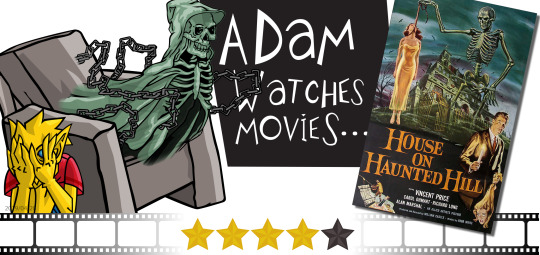
If you dig through a list of movies in the public domain, you’ll mostly find pictures no one should be paying to see. Once in a while, however, you find a gem. House on Haunted Hill is a lot of fun. It’s scary, it’s campy, it’s got surprises, Vincent Price, and a terrific ending.
Eccentric millionaire Frederick Loren (Price) is throwing a party for his fourth wife, the insupportable Annabelle (Carol Ohmart). At an allegedly haunted house he has rented, he's invited four guests. Each will earn $10,000 if they can stay the night. Test pilot Lance Schroeder (Richard Long), newspaper columnist Ruth Bridges (Julie Mitchum), egghead psychiatrist Dr. David Trent (Alan Marshall), simple Nora Manning (Carolyn Craig) and the house’s schizophrenic owner, Watson Pritchard (Elisha Cook) have been carefully selected by Loren… but why?
If you want to know why so many classic horror fans love Vincent Price, watch this movie. Just looking at him, you can tell he’s having a great time, which works perfectly for his character. Is Loren pulling an elaborate prank on everyone? Is he scheming? Is he the one being fooled? You don’t know but you can’t wait to find out. It’s clear there’s something wrong with this house. Is it something genuinely supernatural? Hard to say. There are hints of ghostly business but that setup with the millionaire and his wife… it makes you think something's up. Things get trickier when we being following the individual guests. Some get a lot more screen time than others (which show that perhaps five guests were too many for a 75-minute movie) but each brings a new level of intrigue to this story. Nora, in particular, feels like the one you want to watch most closely. This place is rapidly grinding away at her sanity. You have a feeling the tragedy hinted at in the opening monologue has something to do with this woman.
Something about this picture simply works. Maybe it’s the cast, but it’s also the look director William Castle gives it. When the spooky stuff begins, a modern film would fall back on special effects and the razzle-dazzle. This film’s low budget didn’t allow it a lot of fancy tricks and the special effects it could afford work remarkably well. They certainly keep you on your toes because many of what you see at first isn’t what it seems… or is it? yes it is. But no! You’re kept wondering right until the end. This is where Castle - with the help of writer Robb White - work in perfect unison with the performers. That final note is one of those “ooooh!” Moments you can never forget. It turns what you sit down to watch with a kind of half-smile into a great film.
House on Haunted Hill would be a great pick to show kids on a Halloween night. It keeps you guessing. The performers are great. It’s moody and creepy but not too scary and above all, it's fun. (On DVD, March 25, 2020)
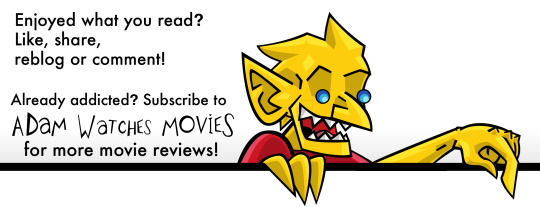
#House on Haunted Hill#movies#films#movie reviews#film reviews#William Castle#Robb White#Vincent Price#Carol Ohmart#Richard Long#Alan Marshal#Carolyn Craig#Elisha Cook#Julie Mitchum#1959 movies#1959 films
6 notes
·
View notes
Text
House on Haunted Hill

The guests are given miniature coffins containing pistols. The hostess hangs herself part way through the festivities. There’s an acid vat in the wine cellar. And a plastic skeleton flies over the audience at a key moment. If nothing else, William Castle’s HOUSE ON HAUNTED HILL (1959, Shudder, Prime, AMC+, Tubi, YouTube) proves the man sure knew how to throw a party. After his first gimmick film, MACABRE (1958), made back almost ten times its cost, Castle realized the real money was in the teen market, so he and writer Robb White made HOUSE ON HAUNTED HILL. Its combination of carnival tricks, Vincent Price and the wonder of Emergo (the flying skeleton trick) brought in more than ten times its cost and set Castle on the road to more gimmick-laden horror films that were camp before Susan Sontag ever used the term. His two films with Price (1959’s THE TINGLER is the other) are probably the best of the bunch, even if HOUSE has some big plot holes and a pretty dreadful damsel in distress.
Price stars as an eccentric millionaire who rents a haunted house (Frank Lloyd Wright’s Ennis House on the outside, a Hollywood Victorian monstrosity on the inside, and no, they don’t look like the same house) and invites four strangers (or so he thinks) and the house’s owner (Elisha Cook, Jr.) to spend the night. If they survive, they each get $10,000, but when strange things start happening, particularly to cash-strapped secretary Carolyn Craig, that begins to seem a pretty big “if.” Although at first reluctant to take part, Price’s greedy wife (Carol Ohmart) starts visiting Craig and handsome test pilot Richard Long to sow the seeds of fear and distrust.
Yes, the film is arrant nonsense. But it’s so much fun only a curmudgeon would care. Price is surprisingly subdued, while Ohmart, originally marketed as “the female Marlon Brando,” is just delicious trading zingers with him. The most fun in the cast, however, is Cook. He keeps popping up with predictions of doom as he gets progressively drunker. Poor Craig is pretty awful; she’s whiny and her terror seems forced (Long deserved some kind of award for keeping a straight face during their scenes). But that actually adds to the camp element. You also get Alan Marshall as a cheesy British psychiatrist who keeps talking about “hysteeria,” Robert Mitchum’s sister, Julie, as a newswoman and Leona Anderson as the blind caretaker who keeps turning up to give Craig something to suffer by.

#horror films#camp#haunted house films#william castle#vincent price#richard long#elisha cook jr.#alan marshall#julie mitchum#carol ohmart#carolyn craig#leona anderson
0 notes
Photo

#house on haunted hill#vincent price#carol ohmart#richard long#alan marshal#carolyn craig#elisha cook jr.#julie mitchum#william castle#1959
1 note
·
View note
Text
Favorite first time watches of July 2024


1. Challengers 2024
2. Scarecrow 1973
3. Pursued 1947
4. Grand Hotel 1932
5. The Locket 1946
6. Ocean's thirteen 2007
7. Longlegs 2024
8. Ronin 1998
#cherry says#THATS RIGHT CHALLENGERS WON THE OSCARS#its july and I am fay wray in king kong and mitchum is my kong i have a wall to block him away from me i have a secret house for him#where i come over to fuck him and go back to my husband when im ready#AND 2 OF HIS MOVIES ARE ON THE TOP 5#HONORABLE MENTION TO JOHNNY DOESNT LIVE HERE ANYMORE
9 notes
·
View notes
Text

Robert Mitchum-Julie London "Más allá de Río Grande" (The wonderful country) 1959, de Robert Parrish.
6 notes
·
View notes
Text



The Wonderful Country, 1959
1 note
·
View note
Text
Robert Mitchum (August 6, 1917 – July 1, 1997) ❤️




83 notes
·
View notes
Text

Robert Mitchum, August 6, 1917 - July 1, 1997.
359 notes
·
View notes
Text
My Revised Ranking of Every David Lean Film
based on how gay they are
Lawrence of Arabia: the reigning champ, the queen of the desert, the only certified canon, 100% gay film in the Lean filmography. Lawrence of Ali are married. There are lots of other romantic subplots as well...
A Passage to India: would it have been gayer, had Merchant & Ivory made it? Yes. It's still, and I can't stress this enough, INCREDIBLY gay...I mean where shall we begin with Aziz and Fielding. They have a meet cute (Fielding is in the shower! Aziz stops by), whenever they talk one of them is usually sitting on a bed, they have a David Lean Train Station Good-bye which is pretty much the gayest thing you can put in a movie and some classic tropes like Fielding covering Aziz as he sleeps, I mean...yeah. Wow. Great movie and I'm in love with Victor Banerjee now so there's that.
Great Expectations: I put this a lot lower on the last list and then people came out of the woodwork to tell me how wrong I was and then started dropping receipts...so I guess I'm willing to admit when I make mistakes. Alec Guinness used his character name from this film, Herbert Pocket, when he was arrested for a homosexual act.
Bridge on the River Kwai: after a rewatch I placed this much higher on the list than last time. There was a lot of stuff I'd forgotten about but especially this scene...
Brief Encounter: yeah it’s practically the template for hetero longing but it was written by a gay man and that checks out: gay men have more longing in their pinky than most people have in their whole body.
Blithe Spirit: Noel Coward again. Witty drawing room comedy where everyone is smashed out of their minds and everyone has slept with everyone…how is this not just gay culture?
Dr. Zhivago: this film is only gay if one day on the 34th viewing your friend goes: wow Julie Christie looks a lot like Peter O'Toole. And then you can’t unsee it and it’s just Lawrence 2: This time they’re in Russia.
Hobson’s Choice: the presence of Laughton alone ups the anti on the queerness of this film. Then there’s the romantic hero of the film. His name is Willie…and he is… just very submissive. Something something metaphor for cock shaming and there’s probably a thesis to be done out of a queer reading of this film.
Summertime: pretend Rosanno Brazzi is a butch lesbian and this is Carol but they fuck and no one dies.
Ryan's Daughter: Lawrence of Arabia screenwriter, Robert Bolt penned this adaptation of Madame Bovary set in Ireland after the Easter Rising. The schoolteacher is played by Robert Mitchum, rather drastically against type after his Max Cady adventures. Charles O'Shaunessy is a very gay coded character who presses flowers and has a hard time fucking his very hot young wife. Nothing to see here...
The Passionate Friends: the addition of Claude Rains to any cast automatically add a bonus 10 Queer points.
Madelaine: I dunno, a women-centered noir with Psychosexual Themes is usually pretty queer.
The Sound Barrier: Lean's shortest film probably took me the longest time to get through....Even Ralph Richardson can not save this one for me. Similar to The Dam Busters and Spit Fire, but without the press of a hot war to up the tension. It's merely a race against the Americans to go a bit faster. I know scientifically it was a big deal, but the stakes are lower and Ralph plays another mean, cold dad character. :( Also, maybe some gayness between the pilots but I couldn't tell them apart well enough so it might have just been onanism...
#David Lean#The Films of David Lean Ranked by How Gay they Are#Lawrence of Arabia#Passage to India#Great Expectations
30 notes
·
View notes
Text

read from beginning | read chapter 20
Lily used the morning’s Prophet to line the cages of the Transfiguration mice. Bits of article titles and bylines peaked out.
Velvet Hats? A 1920s Trend—
By Swelyn—
—ster Mitchum’s Favourite Ba—
Mice scurried over the day’s headline, but nothing could blot it out.
The Minister’s Office Announces New Tough-on-Crime Plan: Spokesman Reports Policy In the Works Since Late July Attack
Lily had read the paper over her breakfast coffee and toast and could think of no better use for the rag. Even Professor McGonagall had let out a small chuckle when she saw what Lily had used for the mice bedding.
Lily was serving her first detention the same morning as the first trip to Hogsmeade—Professor McGonagall pointed out this was not a favor to her.
“You’re needed in the evenings for prefect duties. Though it does benefit you today. I suggest you enjoy Hogsmeade.”
Muggle cleaning was hardly a punishment for Lily, though she wasn’t as used to mouse droppings. After an early start, she managed an early finish.
If I hurry I can get lunch in Hogsmeade!
Her friends had gone on ahead, except for Remus, who was in the Hospital Wing. Just after dawn, Lily made her monthly visit. Luckily, it was before she read the Prophet.
That was for the best. Her face would’ve given away the worst bit of news in the paper that morning. A low-level official had proposed a Werewolf Registry for the tough-on-crime plan. It didn’t even make the main article, Lily learned of the policy through an opinion piece by Lucius Malfoy, strongly advocating for the proposed legislation.
Lily needed a smoke.
16 notes
·
View notes
Text

“Mitchum, like Bogart, has created one of the great screen personae, sleepy-eyed but watchful, laconic but never lackluster, hiding toughness and sometimes menace behind a façade of apparent weariness. Like most other great American screen actors, he denigrates his own ability and hides behind a “natural” performance. Charles Laughton was not deceived. He described Mitchum as “one of the best actors in the world” …”
/ From The Encyclopedia of the World’s Great Movie Stars by Ken Wlaschin, 1979 /
Died on this day: my all-time favourite actor, the incomparably sexy, soulful and multifaceted film noir tough guy and epitome of nonchalant cool, Robert Mitchum (6 August 1917 – 1 July 1997). Off the top of my head, my most treasured Mitchum performances would have to include Where Danger Lives (1950), Macao (1952), The Lusty Men (1952) (pictured), Angel Face (1952) and – of course! – The Night of the Hunter (1954). I also love the big lug’s sporadic forays into calypso and country music in the fifties and sixties, especially when he crooned “Little Ole Wine Drinker Me” in 1967 (“I'm praying for rain in California / So the grapes can grow, and they can make more wine …”). The 2001 biography Robert Mitchum: Baby, I Don’t Care by the late Lee Server is essential reading.
#robert mitchum#film noir#tough guy#lobotomy room#thug#bad boy#little ole wine drinker me#baby i don't care#old hollywood#golden age hollywood#classic hollywood
10 notes
·
View notes
Text
On July 27, 1955, The Night of the Hunter debuted in the United States.

Here's a new drawing of Robert Mitchum to celebrate!
#the night of the hunter#charles laughton#harry powell#robert mitchum#film noir#southern gothic#thriller#national film registry#crime thriller#expressionist film#thriller movies#1950s#50s movies#classic film#classic cinema#movie art#art#drawing#movie history#pop art#modern art#pop surrealism#cult movies#portrait#cult film
2 notes
·
View notes
Photo
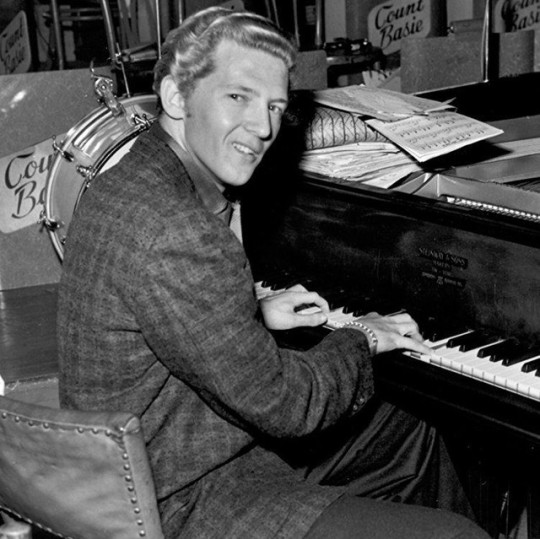
Jerry Lee Lewis, who has died aged 87, achieved dazzling early success as a defining hero of rock’n’roll, when he muscled in among Elvis Presley, Little Richard and Chuck Berry, creating rock’n’roll piano from honky-tonk and hymn, as if doing so were as natural as breathing, and commandeering rhythm and blues with a casual authority achieved by no other white performer except Presley. With Whole Lotta Shakin’ Goin’ On, Great Balls of Fire and High School Confidential, he made three of the genre’s indispensable classics.
These hits, plus unbeatable versions of Mean Woman Blues, Berry’s Little Queenie and many more, shared an immediately identifiable style, an alchemy of the “Sun Studio sound”, fluid vocal brio and a pounding yet lyrical piano. Both hands were crucial in his playing, his striding left hand the foundation of the rhythm, even with a bass guitarist behind him.
Whole Lotta Shakin’ Goin’ On was his second single. Widely banned for lewdness, it sold poorly until Lewis shook up Steve Allen’s national TV show in July 1957, after which he was a star, undertaking nationwide tours while the record sold more than a million. The glorious Great Balls of Fire followed, then Breathless and the title song of the film High School Confidential, in which Lewis performed. All stormed the pop, country and R&B charts.
However, it was all to change in May 1958 when Lewis arrived in Britain. The press discovered that the 13-year-old girl with him was his wife of five months, Myra Gale Brown (who was also his third cousin). His tour was cancelled, Lewis was deported and his career under threat. Jerry confessed his whole hillbilly history: “I was a bigamist at 16 … My wife Myra and I are very happy.” The public were not.
Born in Ferriday, Louisiana, to Mary Ethel, who spoke in tongues, and Elmo Lewis, a labourer, Jerry had two sisters, Frankie Jean and Linda Gail. His elder brother, Elmo Jr, was killed by a drunk driver when they were boys. His father, imprisoned for bootlegging, was brought to the funeral in chains.
Jerry was raised in the Pentecostal church, on family gospel singing and country music by Jimmie Rodgers, Gene Autry, Hank Williams and the state’s singing governor, Jimmie Davis. He taught himself the guitar, drums and fiddle as well as the piano, and hung around a local club, Haney’s, where he claimed he heard top black performers from Duke Ellington to Muddy Waters.
At 12 he made his first paid appearance, moved on to Radio WNAT in Natchez, Mississippi, and at 13 played clubs there, while his cousin Betty Jo Slamper taught him to “smooch”.
Hired as a pianist by a travelling preacher, in February 1952 Lewis married the preacher’s 16-year-old daughter, Dorothy Barton. Jerry Lee, too, was 16. The following year he attended the Pentecostal Bible Institute in Waxahatchie, Texas. Expelled for playing gospel music “like coloured people”, he told them, rightly, that they “might as well accept it, ’cause some day that’s how it’s gonna be”. Back home in September 1953, a month before his divorce from Barton was finalised, he bigamously married a pregnant Jane Mitchum after three days’ jail for store-breaking and stealing a gun. Whether or not this second marriage was ever legalised, it ended in 1957.
In Shreveport he made two country music demos, and in Nashville sought work from Slim Whitman. But rock’n’roll was erupting across the south, and like others drawn to Sun Studios, Memphis, by Presley’s success, Lewis auditioned there. In December 1956 Sun issued Crazy Arms, which sold well despite Ray Price’s version having long been on the charts and despite Lewis sounding almost diffident (not something that would recur). The B-side, End of the Road, one of Lewis’s few compositions, was an authentic dark howl, a perfect expression of its name and place.
At year’s end Lewis played on the sessions for several other artists’ rockabilly cuts, among them Carl Perkins’s Matchbox and Billy Lee Riley’s Flyin’ Saucers Rock’n’Roll. Days later, Roy Orbison asked him to play. Lewis replied: “I don’t do sessions any more.” Later, pressed by a discographer as to who had played on Jerry Lee’s own records, he would offer one of the all-time great ripostes to the collector mentality: “I played on ’em: what the hell else d’you need to know?”
Live, he was an explosive performer in the early years, genuinely close to the edge. And uninhibitedly competitive. Resenting lower billing than Berry on a date at the Paramount Theater, Brooklyn, New York, in 1958, the rumour is that Lewis ended his act by setting the piano on fire. As they met in the wings, Lewis challenged Berry: “Follow that!” Whether or not it happened, it is a rumour Lewis himself perpetuated with glee.
Two 1964 live recordings show his genius. On a tawdry, humdrum date at the Star Club, Hamburg, playing to what sounds like about 50 people, and using, in the tradition of visiting American stars, an English backing group he met mere minutes before showtime, Lewis suddenly rose to a transcendent Your Cheating Heart, with exquisite vocal phrasing and unsurpassable piano, coursing with understatement and grace. In front of an audience of 50,000 in Birmingham, Alabama, he threw down a Hi-Heel Sneakers of shuddering, majestic excitement, stealing the song from all previous occupants.
Following his rise and fall, Lewis remained at Sun, its heaviest star, making rock’n’roll A-sides and wonderful country B-sides of the immaculate Hank Williams kind, years before country became an established new career for ex-rockers. Lewis would be a main player in opening up this route.
He regained the UK Top 10 once, in 1961, with a superb version of Ray Charles’s What’d I Say, its sumptuous thunder Sun Records’s last golden moment. Lewis left in 1962.
On record he lost direction for a time, but toured with an arrogance burnished into art, wilfully infuriating audiences of Teds by dwelling on slow country songs while provoking country crowds with unabashed rock’n’roll. In mid-song he would order a musician to “Play it, son!” only to prevent his doing so with a piano solo no one would interrupt.
For a while he joined the rock festivals circuit, including appearing at the 1969 Toronto Rock and Roll Revival, but by the 1970s he had cracked the mainstream country market with a succession of hits such as What’s Made Milwaukee Famous (Has Made a Loser Out of Me) and the impeccably wily She Still Comes Around (to Love What’s Left of Me). A rangey, muttering Me and Bobby McGee in 1971 was made “to show that damn woman [Janis Joplin] how it should be done”.
Ten years later, his skin waxy and his gait old, he combed his greased hair for the Wembley Country festival crowd, put on filthy sunglasses and delivered a consummate Over the Rainbow: the mic still placed to show off how stylishly his right hand could steer around it, his vocal control sublime. He continued to switch between the two genres for the rest of his career and, as late as October 2009, Lewis opened the Rock and Roll Hall of Fame 25th anniversary concert at Madison Square Garden in New York.
He proclaimed himself for ever a rock’n’roller, through his remaining decades of turmoil, lurid tragedy and farce. His son with Myra, Steve, drowned in their swimming pool in 1962 aged three; one of his two sons with Jane Mitchum, Jerry Lee Jr, died in a car crash at 19 in 1973; Myra divorced him, citing mental cruelty and physical abuse; in 1983 his fifth wife, Shawn Stevens, took a fatal overdose 10 weeks into their marriage, a year after his fourth wife, Jaren Pate, drowned in another swimming pool. Rolling Stone published The Strange and Mysterious Death of Mrs Jerry Lee Lewis, accusing him of murdering one wife and abusing and/or hounding to death several others.
In 1975 his plane was seized with cocaine and 11 kinds of amphetamine on board; in 1976 he was arrested outside the gates of Graceland, drunk in possession of a gun; the IRS seized his property in 1979 and 1983, and he filed for bankruptcy even as Dennis Quaid was making the 1989 Hollywood film of his life, Great Balls of Fire! A short, tax-avoiding emigration to Ireland with his sixth wife, Kerrie McCarver, and their young son, Jerry Lee Lewis III, followed in 1992.
The marriage to Kerrie, remarkably, lasted 21 years, from 1984 to 2005; in 2012 he married for the seventh time, to his former “caregiver”, Judith Brown. There had been decades of medical catastrophe, including a collapsed lung, gall-bladder removal, bleeding stomach ulcers, spinal surgery and car-crash injuries. In 1984 he was twice brought back to life in an ambulance, and had half his stomach removed in 1985, a year his wife said he also spent shooting up methadone, tranquillisers and speed. In old age he also suffered from arthritis, pneumonia and shingles, in Rick Bragg’s 2014 book Jerry Lee Lewis: His Story.
Lewis embodied pinched obduracy, brooding, malevolent ignorance, violent unreliability and borderline madness. He abused women, played with guns and shot at men; he drove the highways of the south blind drunk with his loaded pistol on the dashboard. Yet in the vivid contrast between the meanness of the man and the grandeur of the artist, the common denominators were his phenomenal energy and admirable, all-conquering self-belief.
He will be remembered for his lifetime of hillbilly delirium, but he will be renowned for his seizure of the musical moment at the dawn of rock’n’roll, when an incomparable talent was his intoxicant and ours: when he shot up the old order and played out his defiant dramas on the keyboard, in the studio and on the stage.
He is survived by Judith, and his children Ronnie, Phoebe, Lori and Jerry Lee III.
🔔 Jerry Lee Lewis, singer, songwriter, pianist and guitarist, born 29 September 1935; died 28 October 2022
Daily inspiration. Discover more photos at http://justforbooks.tumblr.com
26 notes
·
View notes
Text


Full Name: Logan Matthew Gilmore (neé Huntzberger)
Birthday: July 12, 1983 (age 39)
Birthplace: TBD
Eyes: Brown
Hair: Blonde
Nicknames: Huntzberger (by everyone), dad, daddy (by Lily)
Residence: Huntzberger Mansion (currently), Logan’s Apartment (formerly)
Occupation: Business Owner
Education: Yale (2001-2006)
Family: Lily Gilmore (daughter), Mitchum Huntzberger (father), Shira Huntzberger (mother), Honor Huntzberger (sister), Josh Martin (brother in law), Elias Huntzberger (paternal grandfather), Lorelai Gilmore (mother in law), Christopher Hayden (father in law), Emily Gilmore (grandmother in law), Richard Gilmore (grandfather in law)
Friends: Colin McCrae, Finn, Rosemary, Juliet, Stephanie, Seth, Paris Geller (frienemies), Lane Kim, Dave Rygalski
Romances: Rory Gilmore (wife, mother of his child), Odette (ex fiancée), Whitney (date)
4 notes
·
View notes
Text
Im gonna watch the omen saga movies, get back to 1951 toshiro mifune and then let robert mitchum take over my entire house and life that's my media plans for July

4 notes
·
View notes